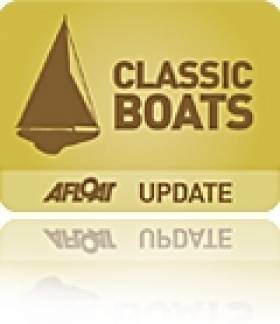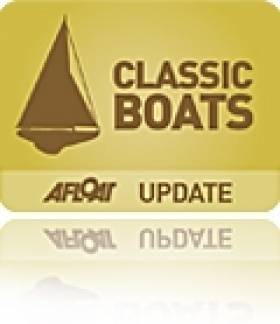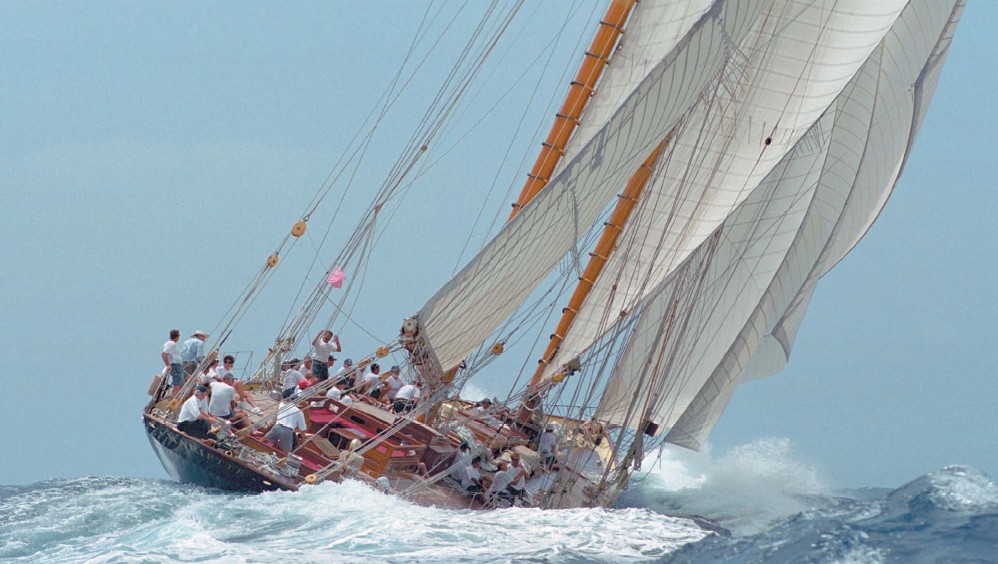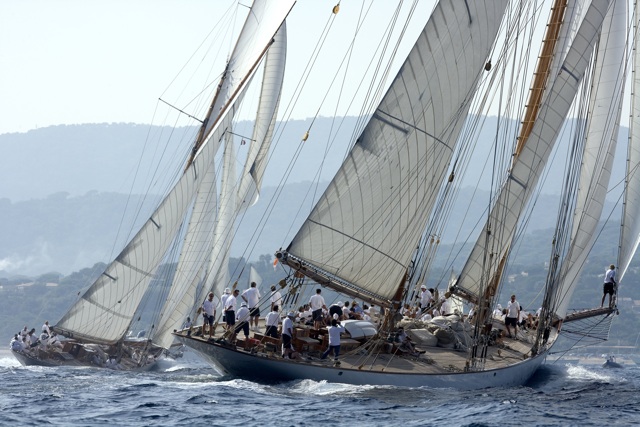Displaying items by tag: classic
Classic Yachts Looking for Wind off Cowes
There may have been no sailing on the opening day of a British Classic yacht week in Cowes, but that didn't stop the competitors having a fabulous time. The schedule called for the Panerai Classic Around The Island Race, with a 7.30am start time, but with little or no wind forecast the Race Committee wisely opted to change the programme and instead proposed a Solent inshore race. Although the morning brought hot sunshine, conditions over the mainland were hazy and the sea breeze stubbornly refused to develop. By 13.00 it was clear the situation was not going to improve and racing was reluctantly called off for the day.
Whilst the lack of racing was disappointing, Panerai British Classic Week is as much about the boats and their owners as it is about the race results, so great fun was still had by all. Cowes Yacht Haven's south basin is awash with gleaming varnish and highly polished brass work and there is nothing classic boat owners love more than a chance to check out each others boats, compare stories and exchange tips, so today gave them the perfect opportunity to indulge.
With nothing to trim or hoist, the cooks in the fleet turned their attentions to lunch and some spectacular cockpit picnics were enjoyed, all washed down with copious quantities of Pimms and well chilled champagne. For others the lure of a swim in Osborne Bay was overwhelming and a number of the crews headed off to the delightful anchorage off Queen Victoria's summer home for a cooling dip.
For Sam Laidlaw and Rob Gray's Sparkman and Stephens designed Clarionet, today's delay was rather welcome as the boat only went back into the water after a major refit this week and there are still plenty of small jobs to finish. Built by Clare Lallow's yard in Cowes, Clarionet is one of the most successful racing yachts of all time. In her opening season of 1966 she won or came second in almost every race she took part in, including winning Cowes Week and the RORC St Malo Race overall. But she was more than a one-season wonder, going on to win hundreds more races in her 47 year career including the 1987 RORC Channel Race, where she beat off the entire 42 strong Admiral's Cup fleet and her class in the 2001 Fastnet. Even at 43 years young she still finished 3rd in class in the 2009 Fastnet racing against some of the hottest modern race boats of the day! After her refit at David Heritage's Cowes yard she is looking as stunning as ever and everyone will be watching eagerly to see if she also retains her winning ways.
Just getting to Cowes has been a major achievement for some of the competitors including Simon Field's Swanilda, a 1960 Nicholson bermudan sloop built by The Berthon Boat Company, and James Kelman's Croix des Gardes, a 1947 Henri Dervin bermudan cutter built by Bonnin Arcachon, both of which sailed across the Atlantic to be here. Croix des Gardes left the 2012 edition of Panerai British Classic Week heading for the Panerai Transat Classique. At the end of that race she cruised through the Caribbean and up the east coast of the United States, before sailing back across the Atlantic just in time for this year's event. As if that wasn't an impressive enough achievement in its own right Croix des Gardes' crew for the entire trip included James's children Elizabeth, six, and Matthew, eight, both of whom were rather disappointed not to be able to race today.
Tomorrow's forecast looks more promising with 10+ knots from the north-east and hot sunshine, which bodes well for EFG International Race Day which will feature one race starting at noon. The regatta continues until Saturday 13th July with racing every day until Friday and a Parade of Sail past the Royal Yacht Squadron on Saturday.
For further information and details about the Panerai British Classic Week please visit www.britishclassicyachtclub.org/regatta.
Glandore Classic Regatta Attracts Inaugural Fastnet Winner, the Pilot Cutter Jolie Brise
#classicboats – Among the regatta highlights of this Summer's Glandore Harbour Yacht Club's Classic Regatta will be the attendance of the French built Pilot Cutter Jolie Brise, winner of the inaugural Fastnet race in 1925.
The CH Marine sponsored Glandore Classic Regatta is held every two years in Glandore Harbour and attracts owners and sailors of traditional and classic working boats and yachts from Ireland and abroad.
This year the Jolie Brise is celebrating her 100th birthday this year and will participate in the Glandore Classic Fastnet race on July 23rd.
The regatta will be officially launched next week in Cork city.
Book Review – Not all Elementary, My Dear Watson
#YACHT DESIGN – If weight, breadth, height and thickness are your primary concerns in evaluating a new book, then this is for you writes WM Nixon. If very high production values, with quality printing, impressive layouts, and the visionary use of a wide range of historic photos are high on your priorities, then this will get your approval. If an inspired text, elucidating many formerly tangled matters of interest in sailing and design history, and all set in a clearly in a comprehensive context which provides a superb socio-economic historical analysis of an important part of Scotland at the height of its maritime, engineering, scientific and industrial glory, then you'll delight in this. But if one of your special pleasures is browsing through a comparative display of properly presented sets of yacht designs, then you'll be disappointed – the few drawings shown in this otherwise magnificent book are little more than sketches used to illustrate changing design trends.
It may well be that the team involved in producing this masterpiece plan to bring out a book of Watson designs in due course – ideally, it might be of broader scope, taking in the designs of all the main Scottish yacht designers. Certainly if the large and varied selection of the more significant designs created by Watson himself, or together with his team as head of a busy drawing office, were included in this volume, then we'd have to think of having neat mini forklift trucks and strong lecterns available for all readers. As it is, it's a bonny baby, chiming in at a smidgin under 3 kilos, or 6lbs 8 ozs if you're in a maternity ward, and it's to the credit of those involved that they've kept it down to this weight, which permits an attractive posting and package service anywhere in the world.
So wherever you are, go for it. This book is right up there with the legendary Royal Cork history in terms of breadth and quality, and in terms of information in many arcane but relevant topics, it's in a league of its own. George Lennox Watson was a multi-talented individual who was the personal expression of Scottish creative and practical genius at its fullest flower. Anyone who thinks only of Glasgow as the place where they invented the deep fried Mars bar will find this work by Martin Black a surprise and a delight, and a cause for admiration of the huge technological and educational advances made by the people of southwest Scotland in the 19th and early 20th Centuries.
Watson died young, aged 53 in 1904. Yet although he was cut off in his prime, such was his contribution to design development at a time of rapid change that, years later, when the great Olin Stephens was asked who he reckoned was the greatest yacht designer of all time, the response was brief: "Watson, of course".
Because it was a magnet for those interested in industry and innovation, Glasgow in its expanding years was one of those places where the emerging Victorian middle classes were soon making their mark. New professions being delineated, and their areas and methods of work codified. Doctors were of course already on the scene, but rapid specialization in medicine saw new disciplines emerging within healthcare. Architects had their functions clarified, as did civil engineers, surveyors and a host of other new professions such as accountancy.
George Lennox Watson, born 1851, came from a well-established medical family, but his own interest was in the design side of the maritime world, and after a brief time as apprentice in the drawing office of a shipbuilding firm, he established his own yacht design office in 1873. He was still a very young man, and far from yacht design being comfortably established as a worthy profession in its own right, until he set up his firm virtually all yacht designers had been employed as in-house developer of design ideas, the employees of boatyards. The idea of a designer setting up his own office and acting as intermediary between owners and several yachtyards was novel – indeed, Watson may have been the first in the world.
It wasn't easy, and as he struggled to establish his firm, and in developing his knowledge of what makes a sailing boat fast, his painstaking and pioneering research was inevitably rather basic. Thus in his early days he tended to be conservative in outlook – he couldn't afford a flop, and he opposed any changes in rating rules which might make his research and his designs obsolete. But the interesting thing is that as the firm of G. L. Watson acquired a sound reputation in the hard-nosed world of Glasgow business, and the toffee-nosed world of big time international yachting, he became more innovative, indeed positively adventurous.
The late 1880s and early 1890s were the times of the most rapid change. The Watson office went from producing narrow-gutted straight-stemmed heavy cutters, briefly through a period of clipper-bowed lovelies, and then very quickly into boats which became personified by the extraordinarily beautiful Britannia, the 121ft cutter design by Watson and built on the Clyde by Henderson for the Prince of Wales, with Willie Jameson of Portmarnock in north Dublin in the honorary but key role of Owner's Representative throughout the building. Jameson was to be the successful amateur sailing master on Brittania for several seasons, and his friendship with Watson flourished until the letter's untimely death a decade later.
Britannia was a first class racer all her life, until George V – who loved the boat with a passion – decreed she should be scuttled on his death, and she was sunk south of the Isle of Wight in 1936. Her near sister Valkyrie II was owned by Lord Dunraven of Adare in County Limerick, whose enormous wealth is credited in this book to his business acumen in buying a hugely successful coal-field in South Wales. I'd been under the impression his acumen lay in marrying a young lady of Wales whose dowry included land which later turned out to be a coalfield, but no matter.
Be that as it may, Valkyrie didn't last as long as Britannia, she was sunk as a result of an epic collision (sadly, one man was killed) while racing in the Clyde in 1894 . But the point is, how is it that Watson's office, having been designing fast but very traditional and ancient-looking racing cutters up until 1890 and later, were suddenly in 1892 proposing these sleek very new-style boats, and seeing them launched in 1893? These wonderful yachts, which still seem modern to us, with their sweet easily driven normal hulls, elegant bows (dismised as "spoons" by conservatives at the time), and virtually separate deep keels. How come?
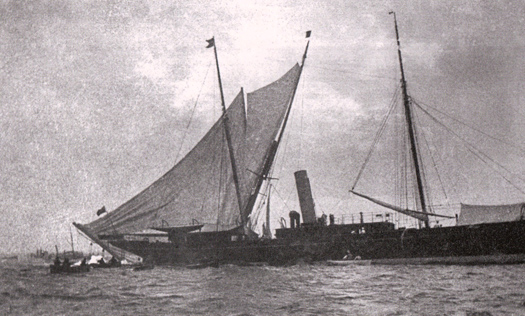
The sinking in the Clyde of Valkyrie II after a collision with Satanita in 1894
By this time the Watson office was a thriving concern, partly thanks to a huge business within it creating enormous steam yachts for the mega-rich on both sides of the Atlantic. With the need to churn out acres of design to meet many needs, innovative young designers were employed as draftsmen in what was a hotbed of creativity and novelty, and they were thus enabled to provide Watson with some very advanced concepts for his approval and development.
Thus some would argue that the prime mover in the Watson office's relatively sudden and very significant shift to more clearly delineated shallower hulls, and the initially much-derided spoon bows, was primarily a young draftsman employee called Alfred Mylne, who later, of course, established himself as a leading designer in his own right. But in 1892, he was still just an employee - anything that came out of the office had to be signed off by Watson himself.

The 10 Rater Dora of 1891 marked a significant change in the shape of Watson's yachts
Though it may have been the 18-year-old Mylne who saw through the change with the first spoon bows for the new 2.5 Rater Ornsay in 1891, and more importantly, the much larger 10 Rater Dora which, like Ornsay, was additionally innovative in having a centreplate, it is a bit unfair of some partisan sailing folk in Scotland to claim that the sensational Britannia and Valkyrie in 1893 were actually designed by Alfred Mylne. However, this book does make the point that after his own work overload became evident in 1895, Watson entrusted all the design work on smaller yachts to Mylne, whom he regarded as his protégée.
The detail on all this and much more can be followed with interest and pleasure, thanks to the complete nature and thoroughness of this book, which does justice to a remarkable man. Watson was immersed in all aspects of design and business – his mantra was: "Straight is the line of duty, curved is the line of beauty'. It's a different spin on the comment by Gaudi, the eccentric architect of the fantastic Sagrada Familia cathedral in Barcelona, that "straight lines are for mankind, curves are of God".
On the business of yacht design, Watson commented: "The designing of cruising-sailing yachts provides a man with bread, that of racers with bread and butter, and that of steam yachts with bread, butter – and jam". But in addition to his main lines of work, Watson had a mission – creating effective lifeboats for the Royal National Lifeboat Institution, which he did for free. This work started in 1887, and by the time the designer died seventeen years later (of heart failure exacerbated by chronic rheumatoid arthritis) the Watson name was synonymous with the best lifeboats in the world, and he had seen the RNLI through, from rowing boats to rowing/sailing boats and then on to motor-powered lifeboats – a motor-powered prototype was being tested in 1904, the year of his death.
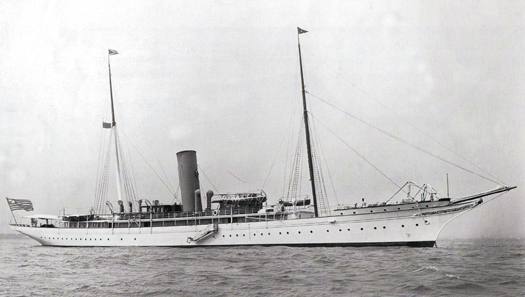
The jam on the bread and butter – in financial terms, the main part of Watson's business at its height was the design of elegant steam yachts for multimillionaires on both sides of the Atlantic. This is the 1266 ton Warrior designed for F W Vanderbilt in 1903
George Lennox Watson was a great and a good man, and this book is as much a worthy tribute to him as a man, as it is to his extraordinary talents as a yacht designer. The maritime community worldwide will be grateful to Hal Sisk, who has brought together the creative team to publish this extraordinary volume, and to Martin Black whose research and dedication have given us an exceptional insight into one of the giants of the already distant world of the late 19th and early 20th Centuries.

The personal mission. From 1887 until his death in 1904, G L Watson worked unpaid as the designer for the RNLI. This is Dunleary, the Kingstown (Dun Laoghaire) No 2 Watson Sailing Lifeboat, built by Hollwey of Dublin in 1898. She was in service until 1914, and saved 24 lives
G L WATSON
The Art and Science of yacht Design.
By Martin Black. 496 pages, fully illustrated, including many previously unpublished photos.
Published by Peggy Bawn Press, c/o Copper Reed Studio,
94 Henry St.,
Limerick
www.peggybawnpress.com
€89 inc p & p worldwide.
Kenefick Steers Chimp to Overall Win at Half Ton Classic Cup
Whilst there was disappointment at losing the two final races it was clear that all felt their Champions were worthy winners and at the prize giving Hampshire's Michael Kershaw and the crew of Chimp received a rousing reception as they claimed the trophy. Helmed by Cork's George Kenefick the crew also included Graeme Love, Ian Brown, Roger Merino and Ed Fitzgerald.

Helmsman George Kenefick from Royal Cork and Chimp crew pick up their prizes. Photo: Fiona Brown
Howth's King One skippered by Dave Cullen finished 14th, not having completed the final three races of the series.
Speaking after racing Michael Kershaw was both thrilled and a little surprised to find himself holding the trophy noting that his crew selection came about as much through luck as judgement and that they had never sailed together as a crew before the first race of the championship. He praised the outstanding quality of the competition and thanked the members and staff of the Royal Corinthian Yacht Club, Race Officer Rob Lamb and his team, the Half Ton Class and Richard and Ursula Hollis who led the Regatta Committee for what he described as a fantastic marker event for the class with so many boats. Certainly 38 boats is possibly the biggest gathering of Half Tonners ever, including the Half Ton Cups of the class's heyday in the 1980s.
Half Ton Classic Cup Day 4
Completing the podium line up were defending champion Philippe Pilate's French team aboard General Tapioca, a 1978 Berret, and Concorde, the 1989 Gautier design, owned by Francis Marshall from Cornwall. The battle for third between Concorde, Tim and David Cunliffe's Insatiable and Robbie Tregear's Per Eilsa had been fierce and Francis Marshall was thrilled to receive his third prize having beaten both boats by just 1.7 points. Insatiable claimed fourth on count-back with Per Elisa fifth.
In the Production Boat Division the winner was Francois Michelin's Chani, one of Ron Holland's wonderful Golden Shamrocks. In second place was the SJ32 Fletcher Lynd, owned by Fredric Denis, and Michael Langhan's Albin Ballad Strolch came third.
There were also plenty of humorous prizes including a bucket and spade for Sibelius who went aground on Ryde Sands, a No Parking sign for Red Cloud who took up temporary residence on one of the marks, and a Best Party Games book for Hullabaloo XV who were the last the leave the bar every night! Special prizes were also awarded to General Tapioca, Ian Van Burn's Fantasy and Toni Stuschek and Janne Tulokas' Blues in recognition of having competed in all five editions of the revival Half Ton Classic Cup.
Arguably one of the most important prizes of the entire event is the Half Ton True Spirit Trophy, which is awarded not to the winning team, but to the team that best represents the true spirit of camaraderie and competition in the Half Ton Classic Class. The members of the fleet elect the winner and by a massive number of votes the 2011 recipient was confirmed as Jean-Benoit Boels' Envol crewed by Diego Boels, Lionel Coquelet, Bert Jansen, Olivier Michel, Adrien Michele and Tom Jansen. At 11 years old Tom Jansen was also the youngest competitor and it was a lovely sight to see him proudly holding aloft the keeper prize, a unique canvas printed photograph by local photographer Hamo Thornycroft.
Class Chairman Bert Jansen concluded proceedings by once again thanking the 38 teams from seven nations for making the trip to Cowes and invited them to join him for the 2013 edition of the Half Ton Classic Cup, which will be held in France at a venue to be confirmed.
Howth's King One Among 38 Entries to Contest Half ton Classics Cup
The Half Ton Classic Class encourages owners to maintain their yachts in "as original" condition where ever possible which helps to ensure the boats can still race competitively against each other boat on boat as well as on handicap and also keeps the cost of competing in the class within reasonable bounds. The success of this formula is clear to see in the ever-increasing entry numbers for this biennial event. Special prizes are also awarded for the Series and Production boats to encourage as wide a range of competitors as possible.
Alongside title sponsor South Boats, the definitive builder of workboats for the offshore wind industry, the event is also generously supported by daily racing sponsors Wight Vodka, One Sails, Euro Car Parks, Spinlock and Best Water Technology. Local supporters include Goddards Brewery, Red Funnel/Isle of Wight Ferries, Shepards Wharf Marina, Kingston Marine Services and Ocean World/World Leisurewear.
Registration will take place on Sunday 21st August, followed by a Skippers Briefing and a Welcome Reception. Racing runs from Monday 22nd to Friday 26th August with daily prize giving and social events at the Royal Corinthian's delightful waterside clubhouse each evening. The Half Ton Classic Cup Regatta Dinner will take place at the club on Thursday 25th August when competitors will be joined by a number of special guests to celebrate the history and ongoing success of this unique class.
The competitor line up includes plenty of familiar faces as well as a number of new teams, which should make for an exciting competition. Following serious damage when she fell off her road trailer earlier this year there was some doubt as to whether the 1978 Jean Berret designed General Tapioca, winner of the past two Half Ton Classic Cups and owned by Belgium's Philippe Pilate, would be able to defend her title again this year. Fortunately repairs have been completed in time and she will be on the start line on Monday.
Others with an eye on podium positions include fellow 1978 Jean Berret design Blue Berrett Pi, owned by Xavier Van Der Ghinst of Belgium, which took 3rd place in the 2003 and 2005 Half Ton Cups and came 7th in 2007; King One, also designed by Jean Berret but this time as the prototype of the fantastically popular Evolution production boats, which won the 1981 Half Ton Cup with Paul Elvstrom as skipper and is now owned by Howth's David Cullen; Demolition a 1981 sister ship to Stephen Jones' legendary Smiffy which makes the trip to Cowes from Falmouth with owner Mel Sharp; David Evans' hugely successful Hullabaloo XV, a 1978 Stephen Jones Hustler 32 from the Walton Backwaters; and Sevcon Team Chia Chia, designed by Hugh Welbourne in 1984 and travelling from Liverpool to compete with owners Phil and Alex Eagleton and Nigel Waterhouse. The furthest travelled boats are Finland's Blues, owned by T Stuschek and J Tulokas, and Spain's Half' Capone, owned by Jean-Luc Courbon.
Click here for a full entry list.
It is already being heralded as one of those rare ‘must see’ occasions when four of the most beautiful Big Class classic yachts in the world will be racing together off Cowes, Isle of Wight, between 5th – 10th July, as they compete to win the inaugural Westward Cup Regatta.
The Regatta is being organised by three of the most prestigious yacht clubs in the world, namely the Royal Yacht Squadron (RYS) and two partner Clubs, the New York Yacht Club (NYYC) and Yacht Club de Monaco (YCM). It is very much hoped that this event will mark the revival of and interest in Big Class yacht racing in the Solent and around the world over the coming years.
Initiated by the owner of one of these Big Class yachts, Eleonora, a replica of Westward, to commemorate the 100th anniversary of Westward’s launch, the organisers have set out to replicate a style, class and regatta atmosphere matching the period when Westward and the Big Class yachts all raced in Cowes, the birthplace of such elegant racing during the 1920s and 30s.
A number of Big Class yacht owners have been personally invited to race against each other over 40-50 mile courses similar to those that these yachts or their predecessors will have sailed in those golden days of Big Class racing. It is still very much hoped that the 15 metre William Fife-designed Tuiga, built in 1909, will also make it to the start line.
Depending on the weather conditions, the schedule may include a race around the Isle of Wight. With the advent of 21st century tracking technology starting to introduce yacht racing to a far larger and global audience, armchair enthusiasts will be able to follow the yachts’ progress online as they sail their courses with each being fitted with a Yellowbrick Tracking device.
Safety is paramount
With the ‘traffic’ conditions in the Solent having changed quite considerably since those early days of racing in somewhat quieter waters, safety is paramount. There will be a large exclusion zone around the Royal Yacht Squadron start line, a safety officer on board each of the competing yachts as well as a support RIB for each of the yachts. Those safety measures put in place will greatly benefit from the wealth of race organisation experience available at the Royal Yacht Squadron, including its highly successful running of the 2001 America’s Cup Jubilee.
In terms of the racing programme, four days of racing and a rest day have been scheduled and the sailing instructions will adhere as closely as possible to those recently agreed by “La Belle Classe”, an association of classic yachts initiated by the YCM. There is also a superb social programme lined up for the owners, their guests, captains and crew.
The Event is also being supported by Boat International Media as a media partner.
Spectating
This exquisite fleet of Big Class classic yachts will, generally speaking, be racing within the confines of the Solent and everyone can watch the starts and finishes in Cowes for the duration of the Westward Cup Regatta. The key vantage points are along Cowes Parade and below the Castle parapet, and along Princes Green to the West.
It is incredible that these huge yachts carry a racing crew of up to 40 and can take up to half an hour to put up and another half an hour to take down their sails.
Owing to the amount of room these boats need to manoeuvre, there will strict on-water guidelines in place for all spectator and pleasure craft and safety boats patrolling.
The Westward Cup and regatta trophies
An English Silversmith, Mr Richard Parsons, has been commissioned to design and build the Westward Cup, a perpetual trophy being crafted on behalf of the owner of Eleonora, in celebration of the centenary of Westward’s launch in July 1910. The Cup will be similar in design to the Cup that Westward won when she was racing in the Solent and will be presented to the overall winner of the inaugural Westward Cup Regatta in July 2010. There are keepsake trophies for the overall winner, and second and third overall.
As each of the four race days is being sponsored by one of each of the participating yacht clubs and one by Boat International Media, there are also Club trophies and keepsake trophies to be presented.
The competitors
The organisers confirm that the following four Big Class yachts will be on this historic of start lines:
Eleonora – Using original drawings from the Herreshoff Manufacturing Company which built Westward, and from close study of contemporary photographs, Eleonora is an exact replica of her famous antecedent. Built in Holland at Van der Graaf Shipyard in steel, she was launched 90 years to the day of Westward’s launch, on 31 March 2000. Since then she has been a regular and successful competitor on the Classic yacht circuit. Superbly fitted out in mahogany, with period details, she has two doubles and one twin stateroom and a full-beam owner’s stateroom aft.
LOA 49.5m (160ft)
LWL 29.3m (96ft 1in)
Beam 8.2m (27ft 1in)
Draught 5.2m (17ft 1in)
Sail area 1,115m2 (12,000sqft)
Displacement 214 tons
Britannia - The Kings’ (she was owned by three British sovereigns: Edward VII, George V and briefly Edward VIII) Britannia is undoubtedly the most famous of the Big Class yachts winning, in a career that began on the Clyde in 1893 until her scuttling off St Catherine’s in 1936, 360 prizes (I, II, III) in 635 races – a record that can never be equalled. Her wooden – as opposed to the original that was composite, wood/steel framed – replica was built in Russia near Archangelsk over a period of 12 years, her launch mired in legal battles with the yard. Her owner, Norwegian Sigurd Coates, is to base her in Cowes and the Westward Cup Regatta will be her first outing.
LOA 37m (121ft 6in)
LWL 26.7m (87ft 9in)
Beam 7.1m (23ft 3in)
Draught 4.6m (15ft 1in)
Sail area (original rig) 930m2 (10,000 sqft)
Displacement 154 tons
Mariquita - Mariquita (Spanish for ‘ladybird’) is the sole survivor of the 19 Metre Class, whose racing career flourished for two brief seasons before the First World War. Designed and built by William Fife at his Fairlie yard in 1911, Mariquita along with Corona, Norada (Nicholson) and Octavia thrilled the racing public from Kiel to the Clyde, where they arrived having braved a North Sea gale. After the collapse of the class, Mariquita went cruising and eventually, minus her keel and rig, became a houseboat at Pin Mill, Suffolk. She was rediscovered in 1991 by William Collier, and restored on the Hamble by Fairlie Restorations in 2004. A winner at Imperia she attended the Fife gathering on the Clyde in 2008.
LOA 38.1m (125ft)
LWL 20.1m (66ft)
Beam 5.3m (17ft 4in)
Draught 3.7m (12ft)
Sail area 585m2 (6,260sqft)
Displacement 79 tons
Mariette - Built in 1915, Mariette was designed by Nathanael Greene Herreshoff for J Frederick Brown of Boston, a successful wool merchant, who raced and cruised her along the North and South Shores of Boston from 1916 to 1927. Renamed Cleopatra’s Barge under Francis K Crowninshield’s ownership, she was requisitioned by the American Navy during the war and declined thereafter. Restored at Cantiere Navale Beconcini in1995, she is owned by Thomas Perkins, of San Francisco, who re-rigged her as original. She returned to New England waters and competed in the New York Yacht Club's Atlantic Challenge. She is a regular and successful competitor in Mediterranean classic events.
LOA 42.06m (138ft)
LWL 24.38m (80ft)
Beam 7.19m (23ft 7in)
Draught 4.8m (15ft 9in)
Sail area 750m2 (8,060sqft)
Displacement 165 tons



























